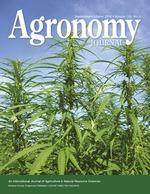Ver ítem
- xmlui.general.dspace_homeCentros Regionales y EEAsCentro Regional Entre RíosEEA ParanáArtículos científicosxmlui.ArtifactBrowser.ItemViewer.trail
- Inicio
- Centros Regionales y EEAs
- Centro Regional Entre Ríos
- EEA Paraná
- Artículos científicos
- Ver ítem
Spatio-Temporal Nitrogen Fertilizer Response in Maize: Field Study and Modeling Approach
Resumen
Maize (Zea mays L.) yield and its response to nitrogen (N) are affected by the spatial variability of the interaction between weather, management, and soil properties. The objectives of this study were (i) to evaluate the response of spatial variability of maize yield by homogeneous zones (HZs) to different N fertilizer rates under rainfed conditions, (ii) to test the ability of the SALUS (System Approach to Land Use Sustainability) model to simulate the
[ver mas...]
Maize (Zea mays L.) yield and its response to nitrogen (N) are affected by the spatial variability of the interaction between weather, management, and soil properties. The objectives of this study were (i) to evaluate the response of spatial variability of maize yield by homogeneous zones (HZs) to different N fertilizer rates under rainfed conditions, (ii) to test the ability of the SALUS (System Approach to Land Use Sustainability) model to simulate the effects of N rates on maize yield under rainfed and irrigated conditions, and (iii) to estimate spatial and temporal N fertilizer response risk in maize through the use of long-term simulations. In two field experiments in Parana, Argentina (−31.8333°, −60.5167°) in 2011 (Field 1) and 2012 (Field 2), four fertilization treatments (0, 70, 140, and 210 kg ha−1) were evaluated in different HZs. The SALUS model was used to evaluate spatial variability in yield, N response, and net revenue over the long-term period (1971–2012). Results showed that yield was significantly affected by N rate (p < 0.01) in both fields and by HZ in Field 2 (p < 0.05), whereas N response was only affected by N rate. Simulated yield was significantly affected by N. The model accounted for the spatial variability, showing HZ effect (p < 0.001) and a significant HZ × N interaction (p < 0.0001). The optimal economic return N rate differed between HZs in both fields. Our procedure demonstrated the ability to improve N management by the selection of appropriate N rates across the field, thereby improving N use efficiency and growers’ profits and reducing the potential for negative environmental impacts.
[Cerrar]

Autor
Fuente
Agronomy journal 108 (5) : 2110-2122. (September-October 2016)
Fecha
2016
Editorial
American Society of Agronomy
ISSN
1435-0645
Formato
pdf
Tipo de documento
artículo
Palabras Claves
Derechos de acceso
Restringido
 Excepto donde se diga explicitamente, este item se publica bajo la siguiente descripción: Creative Commons Attribution-NonCommercial-ShareAlike 2.5 Unported (CC BY-NC-SA 2.5)
Excepto donde se diga explicitamente, este item se publica bajo la siguiente descripción: Creative Commons Attribution-NonCommercial-ShareAlike 2.5 Unported (CC BY-NC-SA 2.5)

